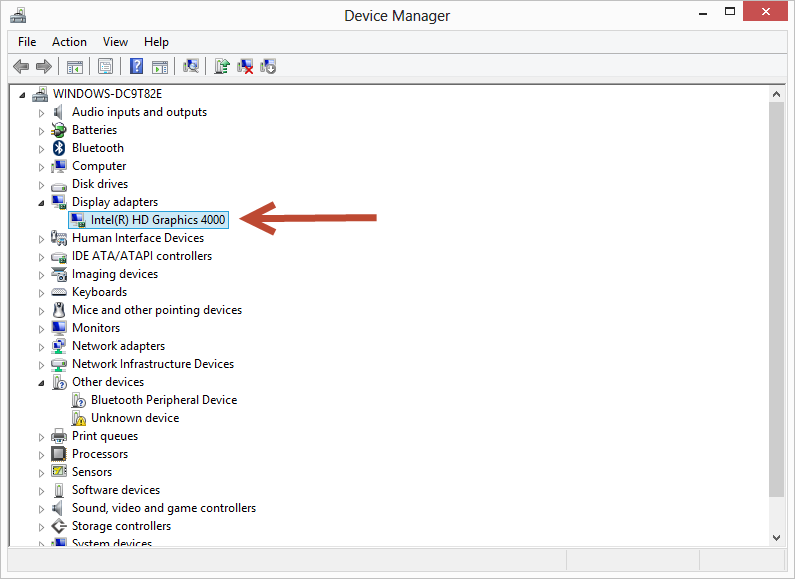| We proberen onze website in zoveel mogelijk talen te lokaliseren, maar deze pagina is nu vertaald per machine met gebruik van Google Vertaal. | sluit |
-
-
producten
-
bronnen
-
ondersteuning
-
bedrijf
-
-
Beginpagina
-
Middelen
- Weblog
- Laptop scherm zwart wordt? Een driver update kan de oplossing zijn!Laptop screen turning black? A driver update may be the solution!
Laptop scherm zwart wordt? Een driver update kan de oplossing zijn!Laptop screen turning black? A driver update may be the solution!
Door Davide De Vellis Oktober 28, 2013Drivers, graphics, laptop, laptop screen, maintenance, screen blackoutNo CommentsWordt uw scherm af en toe zwart? Start de computer dan zelfstandig opnieuw op? Een scherm dat zwart wordt en vervolgens opnieuw start kan worden veroorzaakt door een aantal redenen. Gelukkig is een van de meest voorkomende oplossingen even eenvoudig als het bijwerken van een stuurprogramma.
CHAUFFEURS UPDATE
De eenvoudigste oorzaak en oplossing voor een slecht functionerend beeldscherm is gerelateerd aan het grafische stuurprogramma van uw computer (ook wel video genoemd). Een grafische driver is een stukje software waarmee het besturingssysteem van een computer kan communiceren met het grafische systeem van de computer. De driver wordt meestal ontworpen door de fabrikant van de videokaart van de computer, niet door de fabrikant van de laptop of de producent van het besturingssysteem.
Als u black-outs op het scherm ervaart en uw besturingssysteem onlangs hebt geüpgraded naar een nieuwere versie van Windows, is het zeer goed mogelijk dat een verouderde of incompatibele driver de boosdoener is. Microsoft’s Windows Update zou oude drivers automatisch moeten updaten. Aangezien Microsoft de stuurprogramma’s niet ontwerpt, bevat de update niet altijd alle nieuwe stuurprogramma’s voor elk type computer en componenten.
Video (of weergave) problemen zijn gerapporteerd door nieuwe gebruikers van Windows 8 (en waren ook enigszins gebruikelijk na upgrades naar Windows 7 en Windows XP). Gelukkig zijn er stappen die u kunt nemen om uw stuurprogramma bij te werken, ongeacht welke versie van Windows u gebruikt.
HOE JE VIDEO-BESTUURDER (S) TE UPDATEN
- Controleer de website van uw computerfabrikant
- Controleer de website van de fabrikant van de videokaart
- Navigeer naar uw configuratiescherm
- Klik op “Beeldschermadapters” (dit is hetzelfde in alle besturingssystemen)
- Zoek uw fabrikant (veelgebruikte fabrikanten zijn Nvidia, ATI en Intel)
- Run Driver Reviver
Veel videokaartfabrikanten vertrouwen op laptopfabrikanten om driverupdates vrij te geven. Laptopfabrikanten weten dat er na de release van een nieuw besturingssysteem behoefte is aan updates voor stuurprogramma’s, dus alle beschikbare stuurprogramma-updates moeten op de website van het bedrijf staan, samen met instructies voor het installeren van het stuurprogramma.
De fabrikant van de videokaart is de volgende beste optie als het stuurprogramma niet beschikbaar is op de website van de laptopfabrikant. Als het stuurprogramma voor uw besturingssysteem niet beschikbaar is, kunt u een stuurprogramma voor de systeemversie direct voorafgaand aan de uwe proberen. Als u bijvoorbeeld Windows 8 gebruikt, maar uw fabrikant biedt alleen een update voor Windows 7, probeer die dan en kijk of deze werkt. De meeste updates van de websites van de fabrikant zijn klaar om te installeren, wat betekent dat u alleen op de update hoeft te klikken, op “Uitvoeren” klikt en alle volgende aanwijzingen volgt.
Weet niet wie je videokaart heeft gemaakt? Volg deze stappen om snel het antwoord te vinden:

“Navigeer naar” Configuratiescherm >> Systeem “om de fabrikant van uw Dispay-adapter te vinden”Driver Reviver is een handig programma dat de stuurprogramma’s rechtstreeks bij de hardwarefabrikant of andere vertrouwde bronnen haalt, zodat u zeker weet dat u de juiste stuurprogramma’s voor uw systeem krijgt. Het werkt op alle versies van Windows. Een quick scan kan alle verouderde en verouderde stuurprogramma’s op uw systeem vinden en u een aanzienlijke hoeveelheid tijd en frustratie besparen.
Werkt het nog steeds niet?
Als het probleem niet is opgelost met een bijgewerkt stuurprogramma, ligt het probleem waarschijnlijk ergens anders. Het kan mogelijk zijn dat uw laptop oververhit raakt. Als de computer warm aanvoelt of als de ventilator constant blaast, moet de computer mogelijk een beetje afkoelen. Probeer een paar uur te gaan zonder het te gebruiken en kijk of het probleem aanhoudt. Als het probleem blijft bestaan, is het misschien goed tijd voor een nieuwe computer.
Het is ook mogelijk dat uw videokaart het einde van zijn bruikbare leven heeft bereikt. Een computertechnicus kan het testen om te zien of dat het probleem is. Als dat het geval is, moet u beslissen of het financieel zinvol is om een nieuwe videokaart te installeren. In veel gevallen is het goedkoper om een nieuwe computer te kopen dan om een nieuwe kaart te hebben geïnstalleerd.
Was this post helpful?YesNoVrij Updates van stuurprogramma's
Update uw stuurprogramma's in minder dan 2 minuten om beter te genieten PC-prestaties - Vrij.
Vrij Updates van stuurprogramma's
Update uw stuurprogramma's in minder dan 2 minuten om beter te genieten
PC-prestaties - Vrij.
Niet het juiste antwoord gevonden?Stel een vraag aan onze community van experts uit de hele wereld en een antwoord in een mum van tijd ontvangen.meest relevant recente artikelen Bedrijf| Partners| EULA| Juridische mededeling| Verkoop/Deel mijn gegevens niet| Beheer mijn cookiesCopyright © 2025 Corel Corporation. Alle rechten voorbehouden. Gebruiksvoorwaarden | Privacy | CookiesPin het op Pinterest
-